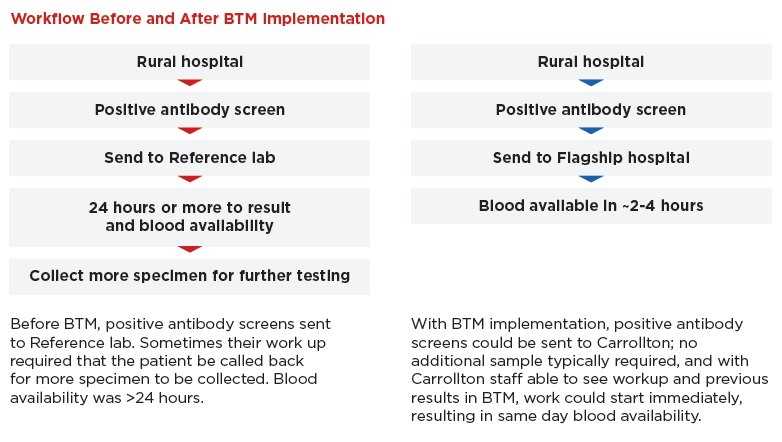Transforming Blood Availability with Grifols Blood Typing Manager

Speed & In-House Efficiency
Before implementing Blood Typing Manager, Tanner Health System, a 5 hospital system with sites in Georgia and Alabama, sent large numbers of samples to the local Immunohematology reference laboratory.
This resulted in delays of 15-24 hours in receiving final results for the patient. With the capability of BTM to provide hospitals in the network to share test results and images of gel cards, Tanner was able to redesign its workflow, sending specimens to an in-house reference site, where samples could be processed more quickly resulting in a significant reduction in time. By reducing the time to result of antibody workup to as little as 2-3 hours, Tanner was able to provide quicker diagnosis, faster treatment decisions, and improve patient care.
| Type and Screens | 7,105 |
| Antibody Identifications | 395 |
| Cord blood evaluations | 386 |
| DATs | 161 |
| Emergency Department Visits | 375,510 |
| Admissions | 63,649 |
| Inpatient Surgeries | 15,571 |
| Births | 8,689 |
Massive Cost Savings & Increased Revenue
Grifols Blood Typing Manager has eliminated major financial burdens, while also generating new revenue streams.
Cost savings:
• $65 transportation fee
• $1,200 stat fee
• $600 average workup fee
Revenue increase:
• Over $10,000 gained in just 6 months
With these financial improvements, hospitals and clinics can redirect resources toward direct patient care, while increasing sustainability and operational efficiency.

Streamlined Efficiency: 73% Fewer Samples Sent to Reference Labs
By processing samples on-site, Tanner has reduced reliance on reference labs by a staggering 73% — boosting reliability, turnaround time, and overall self-sufficiency in blood management. This improvement cuts delays, ensures faster results, and strengthens operational independence.
Seamless Collaboration Between Hospitals
When smaller hospitals send samples to the flagship hospital, theflagship team can preview results on Blood Typing Manager even before the sample arrives — allowing them to jump start the workup process and further reduce wait times. This proactive approach ensures greater efficiency, faster patient care, and improved coordination across hospitals.
This groundbreaking advancement sets a new standard in precision, affordability, and accessibility — proving that innovation in blood typing saves time, cuts costs, boosts revenue, and saves lives.
